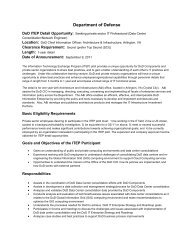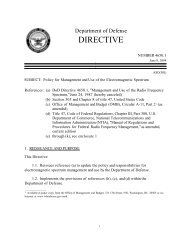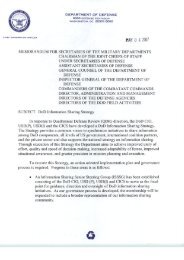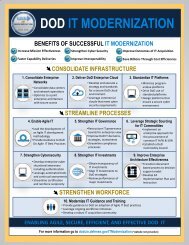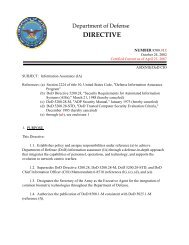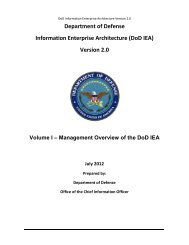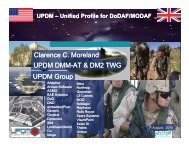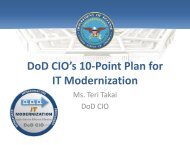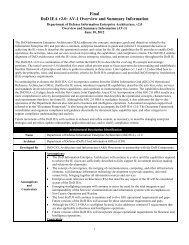DoD Architecture Framework Version 1.5 - Chief Information Officer
DoD Architecture Framework Version 1.5 - Chief Information Officer
DoD Architecture Framework Version 1.5 - Chief Information Officer
You also want an ePaper? Increase the reach of your titles
YUMPU automatically turns print PDFs into web optimized ePapers that Google loves.
Data<br />
Data Model<br />
Data-Entity*<br />
Defense Acquisition<br />
System<br />
Department of Defense<br />
Discovery Metadata<br />
Specification<br />
<strong>DoD</strong> Component<br />
<strong>DoD</strong> Portion of<br />
Intelligence Mission<br />
Area<br />
Enterprise <strong>Information</strong><br />
Environment Mission<br />
Area<br />
Family of Systems<br />
Global <strong>Information</strong> Grid<br />
<strong>Information</strong><br />
interests, missions, or business processes and who therefore must have shared<br />
vocabulary for the information they exchange. (<strong>DoD</strong> Net-Centric Data Strategy, 9<br />
May 2003)<br />
A representation of individual facts, concepts, or instructions in a manner suitable for<br />
communication, interpretation, or processing by humans or by automatic means.<br />
(Institute of Electrical and Electronics Engineers (IEEE) 610.12)<br />
A representation of the data elements pertinent to an architecture, often including the<br />
relationships among the elements and their attributes or characteristics. (<strong>DoD</strong>AF)<br />
The representation of a set of people, objects, places, events or ideas that share the<br />
same characteristic relationships. (DDDS 4362 (A))<br />
The management process by which the Department of Defense provides effective,<br />
affordable, and timely systems to the users. (<strong>DoD</strong>D 5000.1)<br />
To facilitate data asset discovery, the Department of Defense has developed the <strong>DoD</strong><br />
Discovery Metadata Specification (DDMS) as the common set of descriptive<br />
metadata elements that are to be associated with each data asset that is made visible<br />
to the Enterprise Discovery capability. The DDMS defines a core set of elements that<br />
must be used to describe data assets made visible to the Enterprise. (DDMS, v1.3)<br />
The <strong>DoD</strong> Components consist of the Office of the Secretary of Defense, the Military<br />
Departments, the Chairman of the Joint <strong>Chief</strong>s of Staff, the combatant commands,<br />
the Office of the Inspector General of the Department of Defense, the Defense<br />
agencies, the <strong>DoD</strong> field activities, and all other organizational entities within the<br />
Department of Defense. (<strong>DoD</strong>D 8100.01)<br />
The DIMA includes IT investments within the Military Intelligence Program and<br />
Defense component programs of the National Intelligence Program. The USD(I) has<br />
delegated responsibility for managing the DIMA portfolio to the Director, Defense<br />
Intelligence Agency, but USD(I) retains final signature authority. DIMA<br />
management will require coordination of issues among portfolios that extend beyond<br />
the Department of Defense to the overall Intelligence Community. (<strong>DoD</strong>I 8115.02)<br />
The EIEMA represents the common, integrated information computing and<br />
communications environment of the GIG. The EIE is composed of GIG assets that<br />
operate as, provide transport for, and/or assure local area networks, campus area<br />
networks, tactical operational and strategic networks, metropolitan area networks,<br />
and wide area networks. The EIE includes computing infrastructure for the automatic<br />
acquisition, storage, manipulation, management, control, and display of data or<br />
information, with a primary emphasis on <strong>DoD</strong> enterprise hardware, software<br />
operating systems, and hardware/software support that enable the GIG enterprise.<br />
The EIE also includes a common set of enterprise services, called Core Enterprise<br />
Services, which provide awareness of, access to, and delivery of information on the<br />
GIG. (<strong>DoD</strong>I 8115.02)<br />
A set or arrangement of independent systems that can be arranged or interconnected<br />
in various ways to provide different capabilities. (<strong>DoD</strong>D 4630.5)<br />
The globally interconnected, end-to-end set of information capabilities, associated<br />
processes, and personnel for collecting, processing, storing, disseminating and<br />
managing information on demand to warfighters, policy makers, and support<br />
personnel. The GIG includes all owned and leased communications and computing<br />
systems and services, software (including applications), data, security services, and<br />
other associated services necessary to achieve <strong>Information</strong> Superiority. It also<br />
includes National Security Systems as defined in section 5142 of the Clinger-Cohen<br />
Act of 1996 (reference (b)). The GIG supports all Department of Defense, National<br />
Security, and related Intelligence Community missions and functions (strategic,<br />
operational, tactical, and business), in war and in peace. The GIG provides<br />
capabilities from all operating locations (bases, posts, camps, stations, facilities,<br />
mobile platforms, and deployed sites). The GIG provides interfaces to coalition,<br />
allied, and non-<strong>DoD</strong> users and systems. (<strong>DoD</strong>D 8100.1, 19 September 2002)<br />
The refinement of data through known conventions and context for purposes of<br />
B-2




